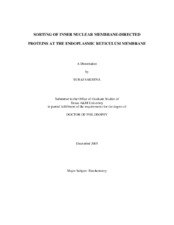| dc.description.abstract | The current "diffusion-retention" model for protein trafficking to the inner nuclear membrane (INM) proposes that INM proteins diffuse laterally from the membrane of the endoplasmic reticulum into the INM and are then retained in the INM by binding to nuclear proteins or DNA. Because some data indicate that the sorting of baculovirus envelope proteins to the INM is protein-mediated, we have examined the early stages of INM protein integration and sorting using photocrosslinking. Both viral and host INM-directed proteins were integrated cotranslationally through the endoplasmic reticulum translocon, and their nonrandom photocrosslinking to two translocon proteins, Sec61± and translocating chain-associated membrane protein (TRAM), revealed that the first transmembrane sequence (TMS) of each viral and host INM-directed protein occupied a very similar location within the translocon. Because few TMSs of non-INM-directed membrane proteins photocrosslink to TRAM, it seems that the INM-directed TMSs occupy different sites within the translocon than do non-INM-directed TMSs. The distinct proximities of translocon components to INM-directed TMSs strongly suggest that such TMSs are recognized and initially sorted within the translocon. Previous work with the envelope protein ODV-E66 (E66) showed that E66 trafficking to the INM is mediated via an INM sorting signal (Sorting Motif or SM). In this study, using a site-specific crosslinking approach we demonstrate that following ER membrane integration, the SM is adjacent to two viral proteins: FP25K & BV/ODV-E26 (E26). Deletion of FP25K from the viral genome results in the accumulation of E66 at the ONM, suggesting that FP25K may facilitate protein movement at the nuclear pore. While the role of the E66-E26 interaction remains to be determined, these data suggest that E66 trafficking to the INM is a protein-facilitated process. Crosslinking experiments using E66 integration intermediates revealed that during co-translational integration at the ER, the SM is adjacent to two cellular proteins of ~10kDa and ~25kDa, referred to as SMAP 10 (SM associated protein of 10kDa) & SMAP25 respectively. Thus, contrary to the widely accepted "diffusion-retention" model for protein trafficking to the INM, our data indicate that protein sorting to the INM is a multistep process initiated upon membrane integration in which the INM sorting signal sequentially associates with various sorting factors. | en |


